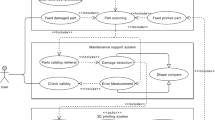Abstract
Measured data of a product can be incomplete because of the inaccessibility or invisibility of some portions of the product surface for measure tools in reverse engineering. Usually, the missed surface areas include some key form features of the product, which represent important design components. However, flat surfaces are often used to mend the incomplete form features in current reverse engineering systems. In this paper, an incomplete data repair method is presented using a deformable model under the constraints of given feature forms. The method ensures the accuracy of identifying the missed local areas by choosing a set of proper rules of mesh construction according to the density distribution of measured data, and fills them with an energy-based, deformable local mesh that is adaptively-formed using an iteration of the procedure of mesh subdivision, constraint satisfaction and finite element equation solving.
Similar content being viewed by others
References
Varady T (1997) Reverse engineering of geometric models: an introduction. Comput Aided Des 29(4):255–268
Rho HM, Jun Y, Park S, Choi HR (2002) A rapid reverse engineering system for reproducing 3D human busts. Ann CIRP 51:139–143
Zhang LY, Zhou RR, Zhou LS (2003) Model reconstruction from cloud data. J Mater Process Technol 138(1–3):494–498
Curless B, Levoy M (1996) A volumetric method for building complex models from range images. In: Proceedings of SIGGRAPH’96, pp 303–312
Davis J, Marschner S, et al. (2002) Filling holes in complex surfaces using volumetric diffusion. In: Proceedings of the First International Symposium on 3D Data Processing, Visualization, Transmission
Verdera J, Caselles V, et al. (2003) Inpainting surface holes. In: Proceedings of the International Conference on Image Processing, pp 903–906
Wang J, Oliveira M (2002) Improved scene reconstruction from range images. In: Proceedings of Eurographics’ 02, pp 521–530
Wang J, Oliveira M (2003) A hole-filling strategy for reconstruction of smooth surface in range images. In: Proceedings of the Symposium on Computer Graphics and Image Processing, pp 11–18
Chalmoviansky P, Juttler B (2003) Filling holes in point clouds. In: Proceedings of Multivariate Approximation: Theory and Applications
Carr J, Beatson R, et al. (2001) Reconstruction and Representation of 3D Objects with Radial Basis Functions. Proceedings of SIGGRAPH’2001:67–76
Montefusco L, Lazzaro D, Morigi S (2003) Filling holes with radial basis functions. In: Proceedings of the Third International Conference on Multivariate Approximation: Theory and Applications
Amenta N, Bern M, Kamvysselis M (1998) A new Voronoi-based surface reconstruction algorithm. In: Proceedings of SIGGRAPH’98
Bajaj CL, Bernardini F, Xu G (1995) Automatic reconstruction of surfaces and scalar fields from 3D scans. In: Proceedings of SIGGRAPH’95
Huang Y, Wang Q, Huang Z, et al. (2004) Mesh boundaries increasing construction algorithm (MBIC) based on local 3D Delaunay. Chin J Eng Graph, pp 46–52
Pfeifle R, Seidel HP (1996) Triangular B-splines for blending and filling of polygon holes. In: Proceedings of Graphics Interface’96 pp 186–173
Kobbelt L, Campagna S, et al. (1998) Interactive multi-resolution modeling on arbitrary meshes. In: Proceedings of SIGGRAPH’98
Terzipoulus D, Platt J, Barr A (1987) Elastically deformable models. ACM Comput Graph 24(4):205–214
Wang X (2003) The finite element method. Tinghua University Press of China, Beijing
Song Q (2003) Research on theory and method for generating blend surfaces. Dissertation, Huazhong University of Science&Technology China
Author information
Authors and Affiliations
Corresponding author
Rights and permissions
About this article
Cite this article
Yunbao, H., Qifu, W., Zhengdong, H. et al. Repairing incomplete measured data with a deformable model under constraints of feature shapes. Int J Adv Manuf Technol 28, 92–100 (2006). https://doi.org/10.1007/s00170-004-2326-x
Received:
Accepted:
Published:
Issue Date:
DOI: https://doi.org/10.1007/s00170-004-2326-x




